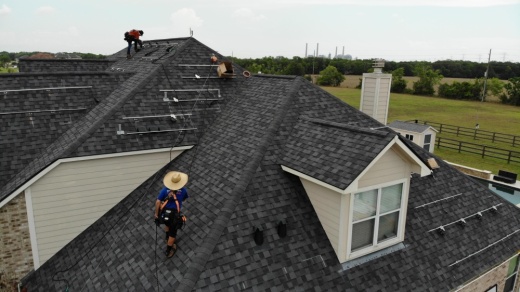Solar power is the fastest-growing source of energy in Texas, having increased 70% year over year in May, according to data from the Electric Reliability Council of Texas, which supplies power to 90% of the state.
“By 2050, the world’s population will consume 20% more energy than we do today, and we need more, not fewer, sources of energy to meet that demand with lower emissions,” according to the Greater Houston Partnership said in its 2021 energy transition report. “We need to invest in new sources of energy and decarbonization technologies that provide humans with clean, affordable and reliable energy to power our future.”
Solar panel permits for single-family residential homes within Houston have surged over the past two years, according to an analysis of city data by Rice University’s Kinder Institute for Urban Research. Permits were issued for 2,408 city addresses in 2021, up from 719 in 2019.
The fourth quarter of 2021 saw the highest permit total for a single quarter so far at 734 permits issued.
Solar panel installations are also up in smaller cities such as Bellaire and West University Place, according to Gage Mueller, a solar energy specialist at the Houston-based ADT Solar. Between June 1, 2021-June 1, 2022 18 permits have been issued in Bellaire, and 15 have been issued in West University Place.
Texas’ power grid has repeatedly been put to the test over the last two years. Between February 2021’s winter storm, which brought on rolling blackouts, and the more recent strain of heat waves causing record-high power demand, new options for energy sources are in high demand, said Dori Wolfe, a coordinator with Solar United Neighborhoods, a nonprofit group that arranges group purchases of home solar installations.
Rise in energy costs
The cost of electricity for residents has risen 10% in the last year, according to the U.S. Energy Information Administration. The average cost of electricity rose to 12.8 cents per kilowatt hour in March. The average home in Houston consumes 1,300 kilowatt hours per month, which would account for nearly $2,000 a year in electricity should costs remain stagnant, EIA data shows.
The rise in electricity bills can largely be attributed to an increase in the price of natural gas as well as higher demand in the summer, according to ERCOT. As the population of Texas increases, so too will the energy demand.
The power demand reached record levels in June. On June 12, Texas energy consumption peaked, reaching approximately 75 gigawatts of electricity for the first time, according to ERCOT. One gigawatt of energy is enough to power 850 homes in Texas a month; the previous record was set in 2019, when 74.8 gigawatts of electricity were recorded.
To push more home installations, Texas offers incentives, including tax exemptions and tax credits, said Mueller. While solar paneling raises appraisal values of homes, owners are not expected to pay increased taxes, he said.
“So you gain the value in the appraisal, but you don’t gain it in the property taxes,” Mueller said.
When installed alongside a generator and/or a battery supply at home, solar energy reduces residents’ reliance on the grid, Mueller said.
“Solar is like the difference between renting your home or owning it,” he said.
An increasingly popular solution to lowering the electric bill is rooftop solar paneling, Wolfe said.
“What we’re seeing here in Houston is it gives you a 12- to 15-year return on your investment, depending on your situation,” she said.
Despite the rise in production, solar energy accounted for roughly 5% of electricity generated in 2021, according to ERCOT. Between January and May of this year, the state’s power grid has become more diverse. Natural gas and coal, which previously accounted for more than half of Texas’ electricity generation, make up 47% of the grid. Wind energy accounts for the largest share of Texas’ grid, contributing a third of all electricity generated in the state, according to ERCOT fuel reports.
Solar efforts
In May, solar energy power output produced 2,390 gigawatts per hour of energy, just under half of what coal generated that month in Texas.
On April 22, the Texas Commission on Environmental Quality granted permits for the largest urban solar farm in the county, located in Houston’s Sunnyside community. The Sunnyside Solar Project will be built on 240 acres of a former landfill in Houston’s south side just east of Hwy. 288.
The solar farm is expected to produce enough energy to power around 5,000 homes, according to city of Houston officials. The plant will be split into two sections: A 50-megawatt array of solar panels will produce energy as part of the wider grid, while a smaller 2-megawatt array will sell electricity exclusively to local residents.
The Sunnyside Solar Project comes on the heels of Houston launching its first solar co-op in 2021, Solar United Neighbors. The co-op is designed to make the conversion to solar more affordable through bulk purchases, allowing homeowners and business owners in and around Houston to select a single solar company to complete the installations. As of January, Houston’s solar co-op had 294 participants.
“The co-op will enable homeowners and business owners in and around the city of Houston to join the growing community of people taking control of their energy bills and improving grid resilience by harnessing solar power,” said Hanna Mitchell, Texas program director for SUN, in a press release.





